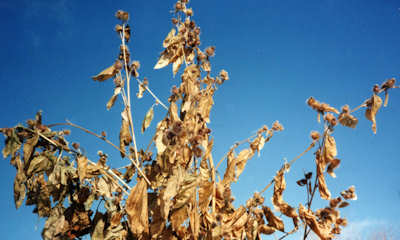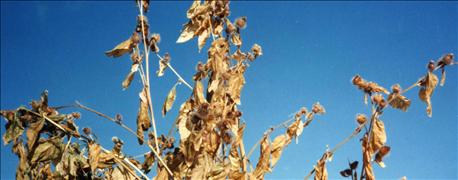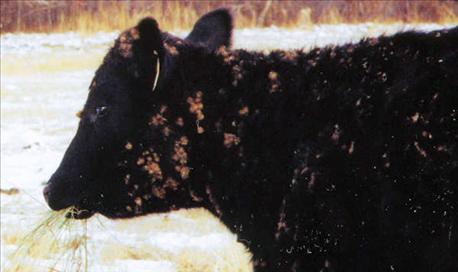September 29, 2015

Eye problems in cattle and horses can be caused by burdock slivers. This prolific plant invades pastures and produces seeds within prickly burrs. Ripe burrs release hundreds of microscopic barbed slivers.
“If a sliver gets into an eye, it can cause inflammation,” says Dr. James England, University of Idaho Extension. “Any foreign material caught in the eye under an eyelid--like cheatgrass or foxtail seed--causes a pain and inflammation. But burdock seeds are harder to find and remove because they’re so small,” he says.

A tough-to-control plant, Burdock is known to cause a range of cattle and horse eye problems.
The affected eye often looks like pinkeye; held shut, watering profusely, with ulcerated cornea from the embedded sliver scraping the eyeball. The puzzling thing is that it occurs in fall and winter—wrong time of year for pinkeye. “Even if I can’t locate the burdock sliver during a careful eye examination, I treat the animal like I would for pinkeye, to combat irritation and infection. Eventually the sliver works out,” England says.
“Ranchers may not be as concerned about the eye issues as just the fact the burdock tends to take over certain areas. It crowds out other plants and nothing else grows there,” he says. Also, the plants are readily spread by animals that get covered with burrs.
Effective control
Chopping it down, mowing or spraying at wrong time of year may be wasted effort and expense. “You must attack it when it is most vulnerable,” says Don Morishita, University of Idaho Professor of Weed Science and Extension Specialist.
“Burdock can be controlled by chopping it down before it’s mature enough to make seeds. Several broad-leaf herbicides kill burdock, if applied properly,” he says.

Burrs cling to cattle coats and can eventually work their way into animal eyes.
Burdock is a biennial; it lives for two growing seasons. “The first year, it doesn’t grow as tall or bloom; it merely grows leaves and accumulates food reserves in its roots, like a carrot, which is also a biennial,” says Morishita.
“The second year it grows a long taproot and tall stalk, with flowers that become burrs. Producing flowers and burrs exhausts food reserves in the root and the plant dies after burrs mature. After the stalk comes up, it’s harder to kill with herbicides because the plant is sending food up from the roots instead of down,” he explains.
~~~PAGE_BREAK_HERE~~~
“The first-year plant stays in a rosette stage that first summer (circular cluster of leaves, no tall stalk) and this is the easiest time to kill it. You can also apply spray in the fall when the plant is putting food into the root, since you have to get herbicide into the root to kill the plant. Use a broad-leaf herbicide like 2,4-D that can move down into the root,” he says.
“If you spray in early spring you kill new young sprouts and last year’s rosettes that are trying to create more food reserves in their root for their big push to complete second year growth and make burrs. You have to spray very early to get the second year plant. After the stalk comes up it is harder to kill,” Morishita says.
“Fall is a good time to spray burdock, to kill young plants that are storing food reserves in their roots for next year’s growth. In spring the second year plant is taking food from its roots to produce leaves and make the big push for tall stalk and blooms. The food is going up and it’s harder to get the herbicide down into the root.”
When using herbicides to kill burdock, don’t overdo it. “If you use too much, it quickly kills the top leaves and doesn’t get down into the taproot. The root survives, to regrow. You want slower kill so the leaves survive long enough to transfer the herbicide down into the root, to kill the whole plant. Use the recommended rate, and spray plants lightly--until they are barely wet but not dripping,” he explains.
Chopping plants down is also effective for control. “The best time to chop is after the stalk is budding but before the burrs are ripe. At that point the food reserves are so low in the root that it cannot regrow,” says Morishita.
Why burdock is so hard to eradicate
It may take several years of diligent control to eradicate burdock patches in a field because the seeds can live a long time. “A single plant can produce up to 15,000 seeds, and a large plant can produce 200,000 to 400,000 seeds, says Don Morishita, University of Idaho.
“Depending on how deep they are buried in the soil, these seeds may survive 2 to 10 years. Even if you chop or spray the plants, there may be viable seed in the ground from earlier years that will sprout and grow. Keep checking those patches, and get rid of new plants that grow up from old seeds.”
You May Also Like




